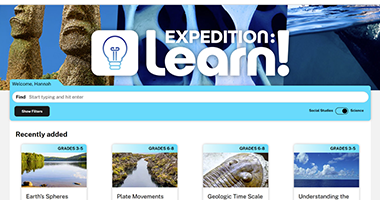Thematic learning is an instructional form of teaching where focus is placed on using a particular theme to teach one or more concepts. The theme is demonstrated using a variety of resources and information.
The pedagogy behind Thematic Learning is that children learn best when learning is holistic, with an “emphasis on making connections in knowledge” (Ward, 2003, p. 13.2) and connections to real life experiences. Thematic Learning is “extremely effective both for integrating the curriculum and for teaching skills in context” (Ward, 2003, p. 13.2).
How to Implement Thematic Learning?
1. Pick a Theme
Your options are positively endless when it comes to choosing a theme for your thematic learning unit. However, there are several factors to consider to ensure your unit is a success:
- Curriculum requirements
- Student and teacher interests
- Stimulus which may result in a themed learning experience e.g. a student question
- Students ability and learning styles
Using Britannica
It’s important to keep in mind the different ability levels and learning styles of your students not just when choosing a theme, but also when selecting learning materials to support that theme. Thankfully, digital technologies have made bridging this divide easier. When picking out resources to use in your thematic unit, always look for sources with accessibility tools or reading support.
For example, articles on Britannica come with built-in read-aloud. The full article content can be read out to students, allowing them to focus on note-taking and summarising researched ideas. Other accessibility features found in Britannica resources include:
- Closed Captioning and Audio Descriptors assists students with hearing or sight impairments.
- Double-Click Dictionary lets students see definition and pronunciation as they encounter unfamiliar words in an article.
- Translation Tool makes it possible for every student to read content in a language they feel most comfortable with.
- Adjustable Font Size lets students personalise their font settings for better display and ease of reading.
2. Integrate Curriculum
An essential step is to ensure that curriculum is integrated authentically into the Thematic Learning. “Thematic approaches (can) have objectives which address the processes of how students learn, and other objectives which address the content of what students learn” (Ward, 2003, p. 13.10).
Using Britannica
Britannica School content is mapped to a number of curriculum standards, making it super easy to find resources that support your theme and curriculum all at once. Go to Britannica School’s “Educators” page to search for content aligned to each standard.
3. Design Instructions
During this phase the teacher and students will organise the activities for demonstrating the theme. In Using Themed Cycles, Geoff Ward of James Cook University suggests that the following framework can be used when planning themed learning:
- Initiating Activities: These activities connect earlier learning and experiences with the intention of preparing students for the new theme while building enthusiasm and interest. This phase starts with one or more stimulus events such as a student’s question or a book reading.
- Enhancing Activities: It is during this phase that the majority of learning will take place through activities based on listening, speaking, reading and writing. Students learn these skills more effectively when they use them in real scenarios during a Thematic Learning cycle.
- Synthesising Activities: During this phase students will connect together and display aspects of their learning. Students need to be given opportunities to talk, write and present their learning for an audience, to celebrate their learning.
Using Britannica
There is a wealth of information and media types that students can safely access from Britannica to support each stage of the learning framework.
- Searchable articles, images and videos on a variety of topics, from animals to technology, and everything in between!
- Biography Browse lets students research modern day and historical biographies in a variety of fields, including science, sports and art.
- Geographical tools give students a different, interactive way of exploring country-specific data as well as studying maps and locations.
- Primary sources are an excellent way to learn about the past using first hand accounts. Britannica’s primary sources include evidence, records and objects from historical events, in the form of letters, speeches and journals.
- If you haven’t found exactly what you were after, then Web’s Best Sites suggests a pathway to broaden your research. Find a list of age-appropriate, reliable websites vetted by Britannica’s Editorial department, containing related information to the article you are currently browsing.
4. Present the Theme
This is the assessment and evaluation phase where students present their learning in a variety of ways. It is closely correlated to Synthesising Activities as outlined above.
Remember:
- Adults learn in the same way, we start with an interest and branch out from there.
- Students play a major role in developing their learning and activities.
- Thematic Learning prevents rote learning and boredom.
- Start small, aim big! Thematic Learning is extremely demanding of teachers so start with a smaller 1-2 week theme then extend the length of time as your confidence and experience grows.
- Pay attention to students’ cues, if they are really enjoying a theme keep it going.
- You can integrate a variety of activities from theme related books, games, puzzles, field trips, case studies, simulations and much more…
- Don’t artificially cover curriculum for the sake of including it in the theme. Ensure you choose curriculum that is naturally and easily connected.
References:
- Cameron, L. (2010). Theme-based Teaching and Learning. Teaching Languages to Young Learners.
- No Author. (n.d.). A Thematic Approach. Show me Wow! Inspiration Teaching Using Limited Resources [Website]. http://www.show-me-wow.com/a-thematic-approach/
- Ward, G. (2003). Using theme cycles. In: UNSPECIFIED, (ed.) Total literacy: Reading, writing and learning. Wadsworth/Thomson Learning, Belmont, CA. https://researchonline.jcu.edu.au/529/2/ward_1.pdf
More Educator Resources
Sign up with your email for more free resources from Britannica.

